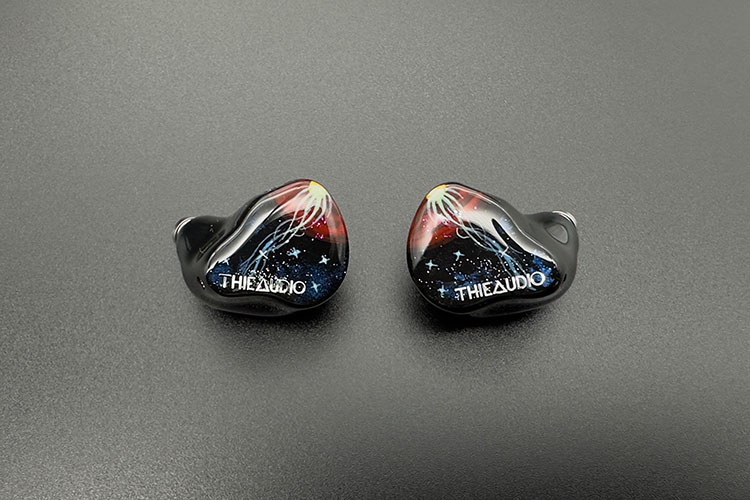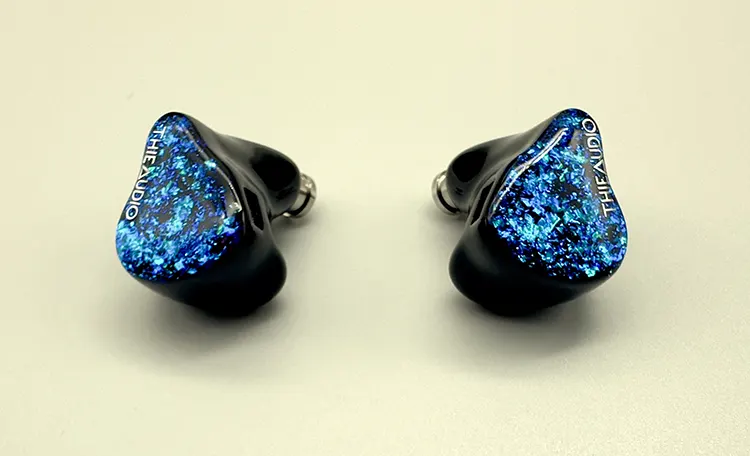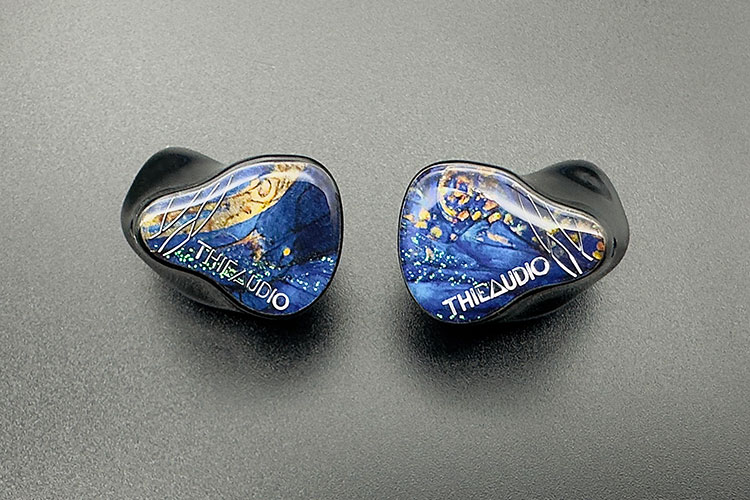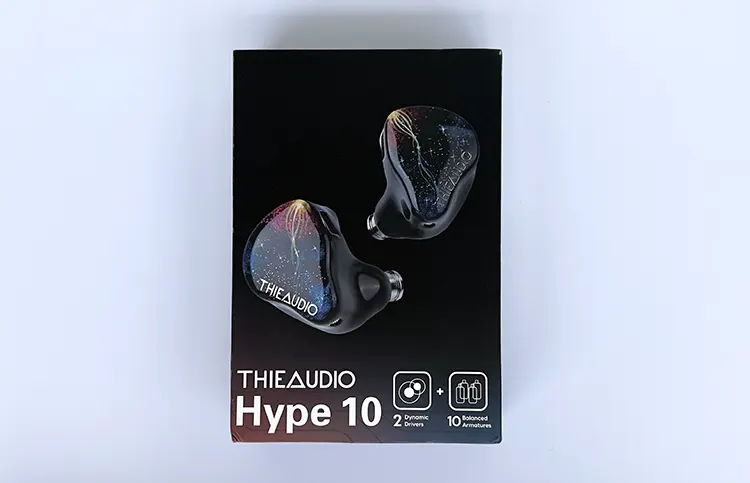Synergy
Efficiency
THIEAUDIO Hype 10 has an impedance of 18Ω @ 1kHz and a sensitivity rating of 105 dB/Vrms. It can be comfortably driven by weaker sources such as dongles and smartphones. It does not need any extra power to shine.
When connected to high-quality devices like the Lotoo Paw Gold Touch (LPGT) or Questyle CMA18P, you get a more spacious sound with richer tonal weight and better dispersion.
In contrast, pairing with sources, such as smartphones or basic dongles, results in a less impressive, a bit dull sound with reduced depth and expansiveness.
Source Pairings
Of all the sources I’ve tried with the Hype 10, the LPGT stands out as the best match. It delivers just the right amount of power and warmth, creating a lush, rich sound that remains balanced.
The bass feels full-bodied, with excellent texture and layering compared to other sources. The treble is smooth but lacks the desired airiness, although the soundstage depth on the LPGT adds a welcome sense of spaciousness.
With the Questyle CMA18P, featuring the AKM 4493 DAC chipset, the Hype 10 adopts a leaner profile with less prominent bass than what we have on the LPGT.
The power output is solid, with occasional hints of static hiss, suggesting that the Hype 10 doesn’t need that much power. However, the pairing still works well, adding a touch of air to the sound.
The Earmen Angel, a powerful source, also pairs decently with the Hype 10. It loses some of the bass’s richness but introduces a nice neutrality to the midrange.
The soundstage feels spacious, but the DAC implementation lacks refinement, making it harder to pick up certain micro details that are more prominent on the other two sources.
Select Comparisons
THIEAUDIO Hype 4
Technical
The THIEAUDIO Hype 4 hybrid IEM features dual dynamic drivers and four Sonion balanced armature drivers. It incorporates the IMPACT2 technology common in the Hype series IEMs, Monarch MKIII, and Oracle MKIII.
Hype 4 has an impedance of 17Ω @ 1kHz and a sensitivity rating of 105 db/Vrms. With similar ratings, the Hype 4 and Hype 10 are as easy to drive. Both do not require any extra juice and can sound full on lower volume levels. On my LPGT, both these IEMs take a volume level of 35.
Talking about the difference in driver configurations, there are an additional four Knowles balanced armature drivers on the Hype 10. All of these drivers are catering to the treble frequencies.
In the low-frequency region, Hype 10 incorporates two Sonion balanced armature drivers to assist the dual dynamic driver setup.
Design
Maintaining a consistent design language across their IEMs, Hype 4 comes with black shells and artistic, shiny faceplates. It also comes in two more options, white and blue.
The white variant has a pearly body, while the black and white options differ mainly in their faceplate patterns, and their shells are black. The Hype 10 has a single variant.
Both IEMs feature similar resin shells, with the Hype 4 having smaller shells. Both provide a comparable level of comfort however, the Hype 4 has a better fit owing to its smaller shells.
The Hype 10 and Hype 4 use 0.78mm 2-pin connectors, but the Hype 10 offers a modular cable with interchangeable terminations, including 4.4mm, 3.5mm, and 2.5mm options. The cables on both IEMs have a similar look and feel.
As for accessories, the two IEMs are nearly identical, arriving in boxes of the same dimensions. The only notable difference is the modular cable included with the Hype 10; otherwise, everything from ear tips to the carry case is the same.
Performance
While the Hype 4 and Hype 10 offer a similar bass quantity, the Hype 10 delivers a more impactful bass with improved texture and layering. If you’re coming from the Hype 4, you’ll notice the increased tactility and intensity in the Hype 10’s bass, making it feel more dynamic.
Hype 10 also offers a richer and more natural midrange than the Hype 4, where the mids can feel more neutral and thinner.
The upper midrange on the Hype 4 can sometimes sound sharper, while the Hype 10 offers a smoother and more refined presentation. Both IEMs provide excellent detail and clarity, though the Hype 10 is more refined sounding.
The Hype 4 already performs impressively in the highs, but the Hype 10 improves upon it with a smoother, more refined presentation.
The Hype 4’s treble can sometimes feel overemphasized, whereas the Hype 10 provides a richer, more detailed treble that integrates seamlessly with the rest of the sound. The resolution in the treble region is noticeably better on the Hype 10, offering more precision where the Hype 4 might overlap slightly.
I would say that the Hype 10 excels with greater refinement, portraying micro-details more clearly and offering a better sense of staging depth. It also surpasses the Hype 4 in instrument separation and layering, contributing to a more polished listening experience.
While the Hype 10 is undoubtedly a more refined and upgraded version of the Hype 4, the significant price gap might give some pause, especially since the Hype 4 remains an outstanding IEM in its own right. Nonetheless, for those seeking an upgrade, the Hype 10 delivers in most aspects.
THIEAUDIO Oracle MKIII
Technical
The THIEAUDIO Oracle MKIII is a tri-brid IEM featuring two dynamic drivers, two Knowles balanced armature drivers, and two Sonion EST ultra-treble tweeters.
It also incorporates the IMPACT2 technology common in the Hype series IEMs and Monarch MKIII. There is a 4-way crossover system implemented.
The Oracle MKIII has an impedance of 13Ω @ 1kHz and a sensitivity rating of 99 dB/Vrms. It can be comfortably driven by weaker sources such as dongles and smartphones. However, the EST drivers mean the IEM can benefit from extra power.
Design
Maintaining a consistent design language across their IEMs, Oracle MKIII comes with black shells and a similar artistic, shiny faceplate. The faceplate features a blue base accented by light brown patterns compared to the darker tones of Hype 10.
Both IEMs feature similar resin shells, with the Hype 10 having larger shells. In terms of fit, both provide a comparable level of comfort.
The Oracle MKIII has a better fit owing to its smaller shells. Both IEMs have the same dimensions of their nozzles, with the mesh on the Oracle MKIII having finer openings.
The Hype 10 and Oracle MKIII use a 0.78mm 2-pin connector and offer a modular cable with interchangeable terminations, including 4.4mm, 3.5mm, and 2.5mm options. The cables on both IEMs are the same.
As for accessories, the two IEMs are identical, arriving in boxes of the same dimensions. There is no difference in the accessories; everything from ear tips to the carry case is the same.
Performance
With two distinct driver configurations, the Hype 10 and Oracle MKIII tuning take different directions. The Hype 10 leans toward a smoother presentation in the midrange and treble, while the Oracle MKIII delivers a more energetic and sharper sound.
Both IEMs provide solid bass quantity thanks to the shared IMPACT2 technology. However, the Hype 10 adds density and impact due to its additional Sonion balanced armature drivers.
While I love the precision and control of the Oracle MKIII’s bass, the Hype 10 enhances this with a bit more body and fullness.
In the midrange, the Oracle MKIII offers a more neutral presentation, designed for professional-grade sound with minimal coloration and a touch of warmth.
In contrast, the Hype 10 delivers a fuller midrange, with richer notes and denser vocals. The Oracle’s upper midrange can occasionally sound ‘spicy’ but never harsh, while the Hype 10’s upper mids are more restrained, with excellent extension.
The treble is where the Oracle MKIII shines, thanks to its dual EST drivers, which provide impressive detail and extension.
The Hype 10’s treble is smoother but lacks the same level of airiness and detail. If you enjoy more energy in the treble, Oracle MKIII’s presentation will likely appeal to you more.
Technically, the Hype 10 excels in creating a spacious, holographic soundstage, while the Oracle MKIII focuses more on width. Both IEMs are comparable for detail retrieval, imaging, and instrument separation, holding their own in these areas.
Alpha Omega Ra
Technical
The Alpha Omega Ra universal IEM has a tribrid multi-driver configuration. There are a total of 7 drivers with a 4-way passive crossover. This includes a 10mm dynamic driver, four Sonion BA drivers, and two Sonion EST drivers.
The beryllium-plated 10mm dynamic driver takes care of the lower frequencies, dual BA drivers for the lower mids, and a second dual driver BA set for the upper mids frequencies. The final 2 EST drivers cover the higher treble frequencies.
The Alpha Omega Ra has an impedance rating of 28Ω @ 1kHz with an SPL of 105 dB/Vrms. Hype 10 is quite easy to drive while Ra takes a bit of extra juice to shine.
Design
The Alpha Omega Ra features resin-built shells that are robust and durable, with each one hand-painted to resemble marbles from a distance. Its shell design is inspired by CIEMs and is as large as the Hype 10 shells. Both have a good fit and ergonomic design, bringing out a similar level of comfort.
The shells of the Alpha Omega Ra can be customized with different colors and paint designs. Ra’s wider nozzle is larger than that of Hype 10’s and can make the fit challenging for some.
Ra connects with a 0.78mm 2-pin connector and comes with a 4-core gold-plated 26AWG Litz copper cable though it is not a modular cable.
Performance
Both IEMs share a similar DNA, offering a musical sound with impactful bass and a sweet, lush midrange. However, the Hype 10 delivers a grander, more open, and fuller presentation.
The Ra’s single dynamic driver provides a decent amount of impact and punch on the lows. The Hype 10 leans more toward volume and quantity, offering a heftier, more substantial low-end.
While the Ra’s bass is more tactile and hard-hitting, the Hype 10’s increased bass presence makes it feel fuller and more enjoyable.
The Ra’s sub-bass digs deeper and hits harder, giving its low end a solid body, while the Hype 10’s mid-bass is more pronounced, resulting in a fuller overall bass presentation.
Both IEMs exude a lush and rich midrange tonality. The Hype 10 stands out with a more natural and cleaner midrange, offering denser vocals and a sweeter, more musical sound to instruments.
The upper midrange on both IEMs avoids harshness, ensuring a smooth experience. The extension towards the upper midrange is better executed on the Hype 10.
The Ra takes a more laid-back approach, with smoother, less energetic highs. It lacks the airiness and sparkle that the Hype 10 brings. However, the Hype 10 also falls short of being truly standout in the treble region but still outperforms the Ra.
I hear a more intimate soundstage from the Ra, while the Hype 10 offers better width and depth, creating a more spacious and open sound.
The Hype 10 also shines in resolution with subtle details coming through more prominently than the Ra. Overall, the Hype 10 feels like a decent upgrade, bringing a more elegant and refined sound.
My Verdict
The hybrid THIEAUDIO Hype 10 is a stellar IEM release, cementing its place as a premium option in the Hype series. Its tuning offers a beautiful balance of technical precision and natural musicality.
I recall auditioning it months ago at an event and being thoroughly impressed. After spending more time with it for this review, my admiration has only grown. It truly showcases THIEAUDIO’s expertise in crafting finely tuned IEMs.
However, the question arises: where does the Hype 10 fit in THIEAUDIO’s lineup? While it offers a clear upgrade in sound over the Hype 4, the significant price gap between the two is hard to overlook, especially considering that the Hype 4 is already a strong performer in its own right.
Furthermore, with the release of the Oracle MKIII, which now features an enhanced bass response, the gap between the Hype 10 and Oracle MKIII becomes narrower.
While the Hype 10 may edge out the Oracle MKIII in sound quality, the price difference leaves some ambiguity about its position within the lineup. Adding to this, there is the Monarch MKIII, which is priced too close to ignore and offers a more refined sound.
That said, the Hype 10’s capabilities are undeniable. It’s a well-tuned IEM that caters to a wide range of genres, making it a versatile choice. One should consider it if you are looking for a premium IEM under 1K USD. It gets an easy recommendation from me.
THIEAUDIO Hype 10 Specifications
- Driver Configurations: 2 dynamic drivers + 10 BA
- Frequency Response: 10 Hz – 40 kHz
- Impedance: 18Ω±1Ω
- Sensitivity: 105 dB @ 1kHz
- Crossover: four-way
- Cable: silver-plated OCC cable, detachable 0.78mm 2Pin
- Modular Termination with 2.5mm, 3.5mm, and 4.4mm interchangeable plugs






